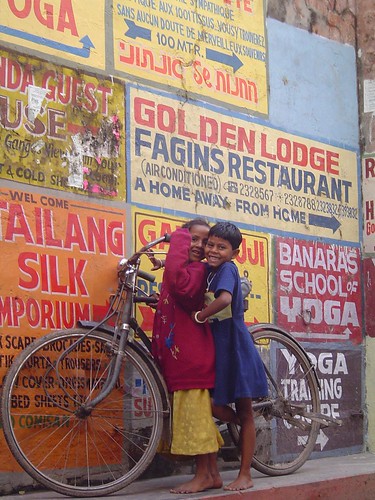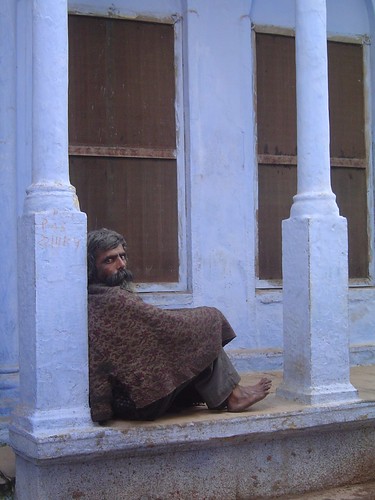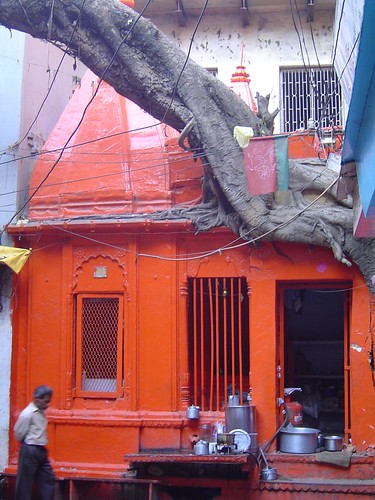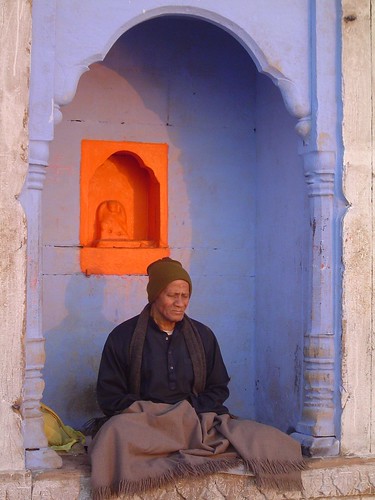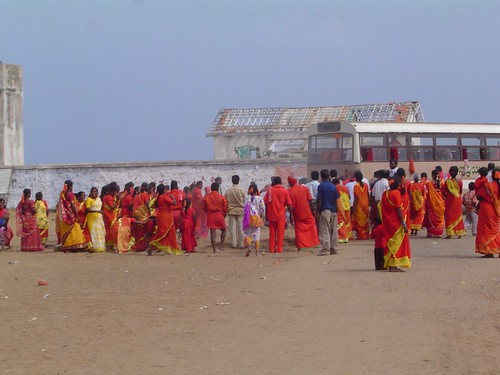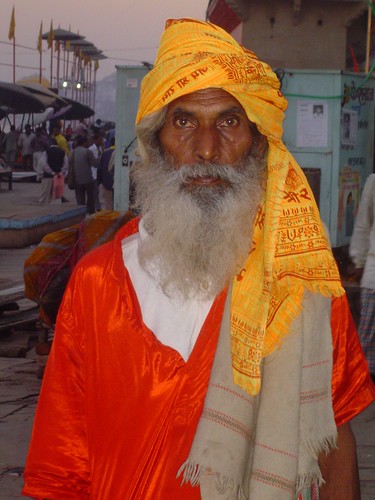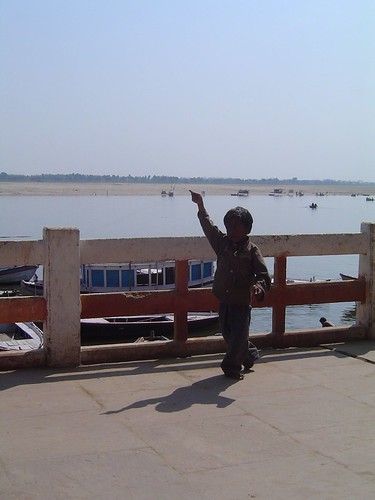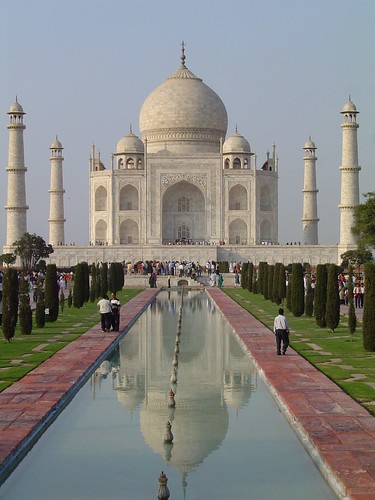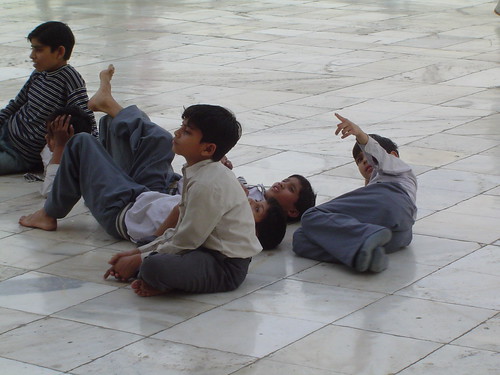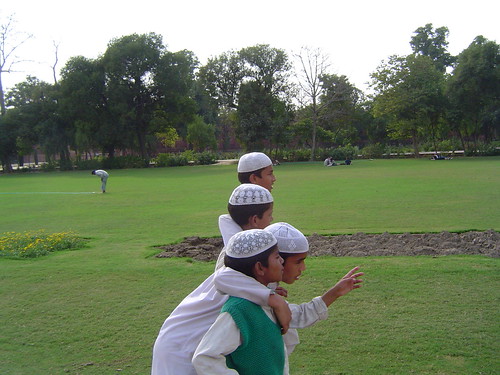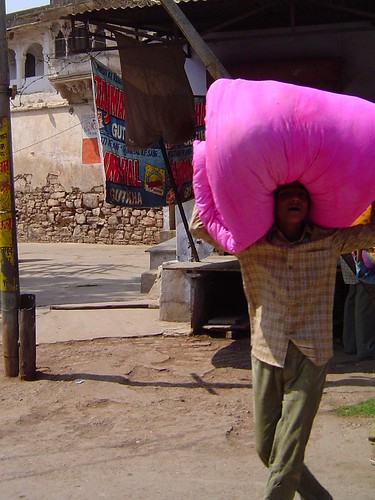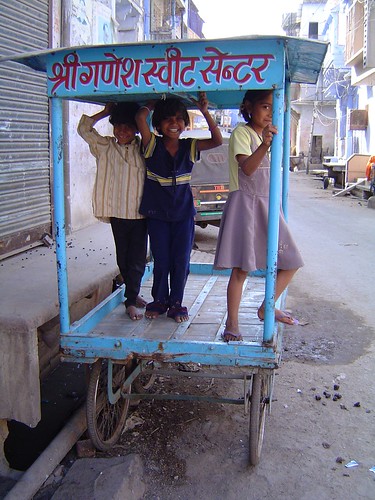several years ago i spent a few months in india doing tsunami relief work and traveling. i didn't realize i'd been bitten by the india bug until i moved back to my comfortable, yet predictable life in new york. it didn't take long for me to relocate to india full-time to try to make a life. now, after three years in mumbai, i split my time between america's east coast and india's west coast. the difference between life here and life there is that everything in india begs to be written about.
Friday, March 25, 2005
Sunday, March 20, 2005
From Delhi to Rishikesh. Well, almost.
*N.B.: The following six articles are part of a series written about
experiences in Rishikesh. They loosely follow one another...they are
best read in descending order.
I arrived in Rishikesh, so called "Yoga Capital of the World," about a
week ago and nearly left immediately. The place didn't match the
descriptions I had heard from other travelers, who described it as a
magical place: a mini and more manageable
to be charming, a place with spiritual energy, but without the grit of
two weeks on the internet, a well-known ashram, and I was excited
about experiencing that kind of atmosphere. But, what I imagined I'd
find—a holy, unostentatious place of quietude and solace—was actually
a bit off, like taking a swig of cold creamy milk, only to find that
it's sour.
Everything looked okay, but the atmosphere was peculiar. Rishikesh
was filled with sadhus and cows, like
poor imitation, like its soul was made of wax. Admittedly, the ashram
was beautiful, with large treed courtyards, slippery tile walkways,
and over 1000 rooms. And, it was almost mystical because chanting
constantly filled the empty spaces in the air. But, while mystical,
the atmosphere was also very unusual. Around every corner were boys
wearing bright orange robes, studying to become priests, and each
courtyard was filled with wildly colorful pastel painted statues of
Hindu gods. Unfortunately, the people I encountered were absolutely
impossible to communicate with—not because of a language barrier, but
because they desired to be difficult—and this did not add to the
experience.
Perhaps I wasn't in the mood for Rishikesh or the ashram experience,
though. The trip started quite poorly in the first place. The bus
from
And, the driver decided not to stop in Rishikesh at all. I shouldn't
have been that surprised. But, it was dark, and I was tired, and not
of the disposition that took this slight lightly.
The way the bus ride transpired was completely Indian in nature: we
left two hours late; we made multiple stops to pick up people on the
side of the road; and, we never made it to our destination. Since I
was the only person on the bus going to Rishikesh, and more people
were going to the next stop, the driver made the executive decision to
just drop me off wherever he liked, which meant, for me, in the middle
of nowhere. I am not a fan of Greyhound, the not-so-sleek American
bus company, but to its credit, I doubt that a Greyhound driver would
ever drop a passenger off on the side of the road at night to fend for
herself.
Usually, I would just accept this sort of situation, but on this
particular night, I was not in the mood, and managed, in the process
of being booted off the bus with all my gear, to throw a royal fit.
After quite a bit of thrashing about and using my "angry woman" voice,
I coerced the ticket collector into giving me money for onward
transportation to Rishikesh. I also told him that he needed to find
me a taxi or rickshaw. He refused. I appealed to the rest of the
members of the bus, hoping that someone would understand me or take
pity and help. I doubt anyone really understood what I was saying,
but from my face and my livid gesturing, I think they got the idea. A
young Indian gentleman spoke up, and told the ticket collector to get
me a rickshaw. He begrudgingly did. It took fifteen minutes for a
passenger vehicle to come along, but he finally hailed a group
rickshaw and we bid each other bitter farewells.
So, after a cold rickshaw ride and a hike to the ashram, I entered my
room and fell into bed. Chanting filled my ears and continued for
hours into the night. I closed my journal entry that night with this
slightly judgmental first impression: "This place is a weird cult."
Ashram
The next day, the Ganges, which divided Rishikesh into two banks,
drank up a cool, steady rain. I walked, arms akimbo, across the
grounds of the ashram concentrating on every step to keep from
slipping on the slick tile walkways. Over email, I had enrolled in a
two week beginner's yoga course at the ashram taught by an American
woman. The course seemed to be a full-service operation including
meditation, asanas, chanting classes, and tutorials in the
Bhagavad-Gita (one of India's most holy texts). That rainy morning I
asked four different ashram people about the "Beginner's Yoga Course"
and was told three different start dates, and, from one particularly
confused fellow, that there was no course at all.
That was off-putting, but not surprising—in India there's often a
different answer to the same question depending on who you ask.
However, I was repelled by something else, as well: "obsessive
Swami-worship." Many ashrams are started and led by a guru of some
sort. And, I have been warned that some ashrams focus on the leader
more than their mission. My ashram was led by a long-bearded,
orange-clad guru whom everyone seemed to adore.
But, over breakfast the first morning, I observed several guests being
shushed. A pleasant looking Indian man told them that silence was to
be observed until 10 AM, because "the Swami is meditating!" One
couple, a newly married Asian bride and groom, both dressed in
spectacular silk clothing, sat in the front office outside the
breakfast area waiting to meet His Holiness, perhaps to have their
marriage blessed. I kept overhearing conversations about how
"impressive He is in person," and how "He doesn't say anything, but
you can just feel His power." I reflected for a moment, over my bowl
of steaming sweet wheat porridge, and then quietly tiptoed back to my
room to pack.
Rain
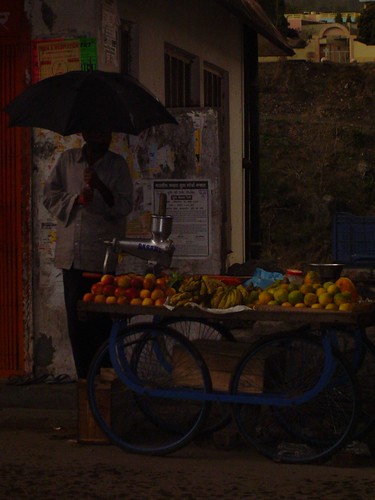
There's nothing like the sound of a thousand raindrops trotting on a tin roof. Today during Pranayama, the breathing portion of our yoga class, the evolution of a storm stole my focus. I neglected my lungs and abdomen and let the thunder bowl through me, its knees and elbows banging into walls, clanging about above my head, taking over the sky.
The raindrops came soon after, loud, like schoolboys spilling marbles on a sheet of glass. After a heavy onslaught, the droplets slowed. Rivulets ran down leaves looking for a nice place to land. Spheres of water tumbled down temple ramparts, happy to roll, and then leap, roll, then leap, picking up speed, flipping over once, twice, splaying liquid arms then curving into a droplet again and galloping over the next edge. It smelled as if God had ripped open a thick, yellow-veined, green leaf and the moist, fresh earthy smell took over everything.
The asphalt darkened into deep slate, and the cow paddies and afternoon detritus dog-paddled to a nearby drainage canal. These narrow, cement canals run parallel to the road on both sides, accepting the debris and dirt that's been discarded in the street.
When it pours, water speeds through the drainage-ways, and little Indian boys and girls kneel to watch, rapt with attention, as trash rushes by underneath them. For an adult, it's difficult not to be disgusted by the junk that bumbles about, bobbing from one side to the other. But, the children must imagine the floating bottles and bits of brown paper and plastic wrappers as bobbing sailboats and flashy fish. A little girl twings a piece of silver foil through a steel grate into the water passing below and smiles as it drops and floats downstream. She sighs with delight at her creation.
I inhale the rain smell, and wiggle into my mat, trying to once more focus on my breath and watch my inner nature, all the while wishing the rain would stage another hoe-down above my head.
Neerag
Even though Neerag is just a boy, I couldn't let him take advantage of me. As a result of my refusal, Neerag wasn't happy with me for the rest of the day, but after he delivered a bucket of hot water that evening for my bath, I gave him ten rupees for his effort. His eyes smiled. He said, "Why?" I said, "Because."
Neerag has a skinny brown body and drags his feet when he walks, but he has a sweet smile and black hair that flops across his forehead. He wears the same plaid button-down shirt, fit for a man three times his size, every day. And every morning, he's up at 6:30 to start his work. From what I can gather from a couple of broken-English conversations with him, Neerag came to Rishikesh ten months ago leaving his mother, father, and an older brother behind in his village (I asked if he has sisters, but ironically, he doesn't seem to know that word).
He claims that the man who runs this little place—six simple rooms and a small rooftop restaurant—is his uncle. Maybe this is true. But, any casual observer can see that Neerag really holds the reins, and hence, deserves to dub himself "Manager" with a straight face. He cleans the rooms, tends to the bathrooms, sets room rates, heats and ferries buckets of hot water (none of the bathrooms have hot water), takes food orders, busses tables, and does the laundry.
I'm not sure when he goes to sleep, but when I came out of my room one night after 11 PM to wash my face across the hall, he was curled on the floor in a pile of blankets. He sleeps on top of a woven mat, and under a wool blanket in the open area between the rooms. When I first saw him there, I thought about letting him sleep in my room on the floor. At least it would be warmer than the drafty hallway. But, I reasoned, it wouldn't do much good at all in the long term, and I'd probably set a bad precedent—from here on out he'd expect young American ladies to invite him into their rooms.
Neerag doesn't go to school. He doesn't play, and even if he did, he doesn't have any children to play with or the time to play. He sees his family two or three times a year. The opportunity for earning money here (and learning English from tourists, for that matter) is seen by his family as much more beneficial and lucrative than sending him to school which would cost money. I have come to learn that Neerag's story is not unique. Quite often, children are sent by their families to big cities like Delhi and Bombay, or touristy places like Rishikesh, to make money. Neerag is just one of several young boys I've seen slaving away during my trip.
I asked him, before I left the guesthouse, if I could take his photograph, but he refused. I don't think he didn't want to—I think he just felt too shy. He leaned against the wall, and he got very silent. I asked him one more time, but he shook his head, "No." I gave him an unnecessarily large tip, and he walked out quietly to get a broom to clean out my room and make it ready for a new traveler.
I wonder what he would rather be doing. Certainly, not this.
Monday, March 07, 2005
The Taj
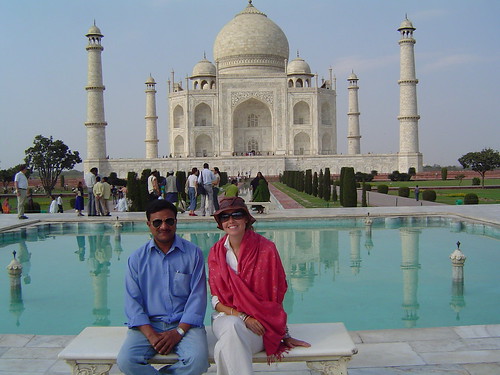
I haven't read the Da Vinci Code. Although it has been on the bestseller list for ages, and numerous friends, from Israel to India to England, have given it positive reviews, I can't bring myself to read it. There's something about the fact that everyone and their mother has read it that makes me shy away from it. Call me Jonathan Franzen (the author who openly expressed disgust at his book, The Corrections, being placed on Oprah's Book Club list), but popular mass
fiction often doesn't live up to the grand reviews and adulation it receives.
Before seeing the Taj Mahal, I felt the same way—reluctant and a bit wary about this place that everyone raves about. Surely someone has hated it and just hasn't had the courage to say so. For some reason, visiting the Taj felt like more of an obligation than a treat, and I seriously considered just not going. But, when my friend, Dr. Steve (a doctor I met at the orphanage in Orissa) came to Delhi and offered to drive me to the Taj, I couldn't refuse. I'd have a friend to go with, get the Indian perspective, and skip out on the tourist bus filled with masses of camera-snapping white folks. Ideal.
Dr. Steve picked me up early and we visited the ruined city of Fatephur Sikri first. Quite fascinating old ruined city that had to be abandoned not long after it was built, because it's creator forgot that water was not readily available anywhere in the area. I have a feeling that it's best when you can spend a day or two walking around, but we only had a couple of hours so we made the most of it. It was stiflingly hot, so after Fatephur we broke for lunch, and recouped on masala dosas and sweet lime soda. Bolstered, we set out for the Taj.
To protect the Taj surroundings from the masses, its caretakers have blocked off the roads leading up to it so that cars and busses can't proceed. You can either walk up the long road to the entry gates, or wrangle a bicycle rickshaw, auto-rickshaw, or tonga--our choice--which is a horse drawn carriage. They aren't as regal as the ones in Central Park, but it's still quite nice to be pulled up the gates of the Taj by a white steed. After you go through the rigmarole at the gates, i.e. emptying your pockets, passing through the metal detectors, being patted down, etc. you can relax and prepare yourself. It isn't in sight yet, so you have a moment to collect your thoughts, and then proceed...ready?
Although I've seen pictures of the Taj many times, there is nothing like laying eyes on it the first time. Resplendent in its bright white marble symmetry, the sight of it opened my eyes wide, and lifted my cheeks a bit. I found myself drawing air into my lungs suddenly and had to sit down to take it all in. Four hundred some odd years old and it is still dazzling!
On a scale of Indian things, I'd say it's not quite as good as hearing 110 children praying at once, but much better than a camel safari, and on par with bathing baby elephants. It truly is the greatest monument to love, and if my significant other ever decided to build a magnificent marble tomb with exquisite inlaid semiprecious stones, and ornate carvings in my honor, I wouldn't object.
Up close, it's nice, too…but I wasn't as impressed by it as I was from afar. In fact, I was much more interested in watching the people visiting the Taj. There were busloads of children wandering about (imagine if this was your typical fourth grade field trip!), and they were the most entertaining. Dr. Steve and I spent a couple of hours taking it all in, and then headed out the front gates where hundreds more people were queuing up to see the sun set on the Taj. Truthfully, I doubt I'll ever go again—once was enough and the impression will, no doubt, last. But, it was most definitely worth the trek.
Note to self: go buy Da Vinci Code.
Boys of Bundi
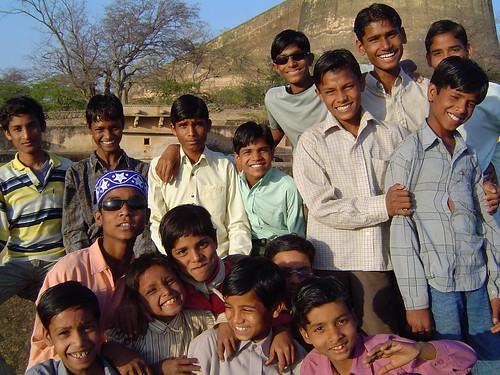
A charming little group of naughty boys that surrounding me as I was walking around Bundi's fort. They didn't speak much English but they all knew how to request that I take their picture. Afterward, I showed them the photo, then asked them all for two rupees--my charge for taking the photo. We all had a good laugh about that...as they are usually the ones asking for small change.
Escher's Predecessors Lived in Bundi
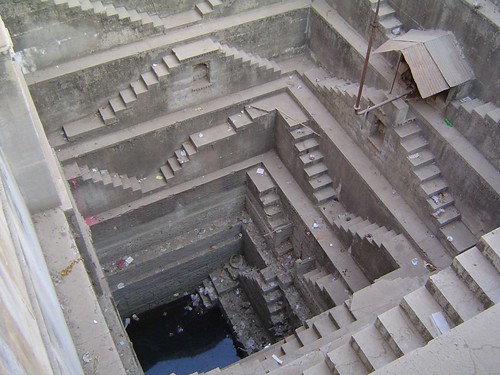
One of Bundi's spectacularly deep stepwells. Several hundred years ago, townspeople would come to the well to bathe before going to the temple to worship. Back then, during the time of the maharaja, the well would have been nearly full to the brim with clean water. Now, the levels are very low. But, during the monsoon, the water rises considerably. This is one of a pair of matching stepwells near the vegetable market in Bundi.
Bundi?
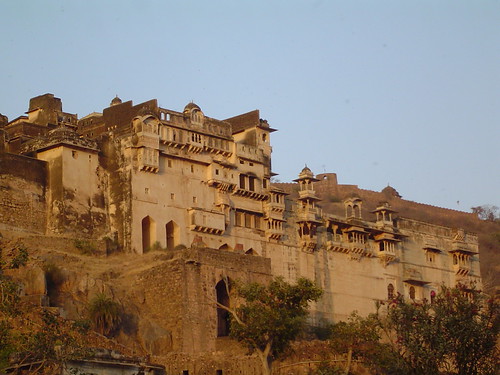
Driving North from Mumbai to Delhi, dodging decorated tractors, and being skirted by smoke-blowing Tata monsters, Bundi expects a double-take. Compared to the miles of hut-strewn villages and roadside chai stands, Bundi seems like a mistake. You look again—it's real. An architect's dream, it's golden-hued palace perches on the side of a hill, like a bird looking out from his aerie to the sights below. Above the palace, fort walls loom ominously at the crest of the hilltop, announcing that this place is worth protecting. And below, a miniature Jodhpur awaits, the houses glowing blue in the waning sunlight, smallish streets showing the way. Where did this fairytale town spring from, and why haven't I heard about it before?
Many people discover Bundi accidentally, as it's on the road between two of India's biggest cities. But, it isn't on a main train line, and the closest hub, Kota, is not much of a destination at all. Essentially, Bundi is rather out of the way, and, truthfully, that's probably for the best. Because it's off the beaten path, Bundi hasn't had seen the influx of tourists that some other places have; therefore, its residents are still quite innocent, the children friendly, the locals desirous to be of help. This is a far cry from some of the overrun areas where men and children can be overtly aggressive, either saying brash and inappropriate things, or patting down your pockets looking for treats and rupees.
I heard about Bundi from a Danish girl who hadn't been, but had met people who had. They had raved, and she told me she was going to go check it out. It sounded nice enough, so, on a whim, I scrapped my other plans to see Udaipur and Mt.Abu - well-known places in Rajasthan- €”and headed for Bundi.
The day I arrived, it was near sunset, and the first cutting of the mustard seed plant had occurred that day. Although it sounds rather romantic, the effect is rather dismal due to a small black fly, quite like a fat gnat, that finds this plant's oils irresistible. When the stalks of the plant are severed, the aroma of the oil fills the air, and billions of these little buggers smell it and swarm with the confidence of locusts, looking for a snack.
Even Indians, who usually seem impervious to the perils of their country (they drink the water, they eat the street food, etc.), were besieged by the flies, and walked through town covering their mouths and noses with the end of their saris or with a cotton handkerchief. I didn't notice the flies until I'd walked down the street about twenty steps. That was more than enough time for them to wiggle themselves into the wet corner of my eye, my warm nostril, my open mouth. So much for my flight of fancy, being footloose and spontaneous. What had I gotten myself into?
I harbored secret wishes that the flies would miraculously disappear by morning, but I heard from a local that they were here to stay. But, even with the little varmints buzzing about, Bundi charmed and wooed like no other place. Due to a vicious asthma attack I had had on a train across the desert, en route to Bundi, I wasn't able to move around much the first two days I was there. I would get winded just climbing a set of stairs, but, luckily, I found refuge in my hotel.
The Kasera Paradise just opened three months ago, having been refurbished after 80 years of neglect. It is a 16th century old haveli with an inner open courtyard that rises up the length of the four story building. On each floor, there is a window seat-cum-compartment (in India, everything is a something-cum-something) fitted with a thick mattress and cylindrical pillows. When you climb into the little cupola, you are essentially climbing into your own little nest that looks out over the town on three sides, through intricate latticework windows. Since I couldn't get around without coughing, sputtering, and wheezing, I soaked up the view and read or wrote in one of these little cubbies for the first two days.
When I did finally venture out into the town, I discovered sweet people, hairy piglets, a bustling vegetable market, young boys wanting to practice their English, and colorful neighborhood temples. Although moving about was tiring due to my weak lungs, the people and the atmosphere were calming and magnetic.
On my third day, I mustered the energy to go up to the palace. I'd spent so long looking at its frontis from the roof of my guesthouse, that I had started to think it quite ordinary, after all, its outer walls were only a matter of feet from the back of the Kasera. Other guests had told me that the palace had incredible frescos and an interesting stepwell where the queen once bathed. But, from my seat on the roof of the hotel, the palace looked like it couldn't possibly hold that much of interest. It looked pleasant from the outside, but I had no idea how huge it really was. Upon climbing the steep road up to the entry gates, I entered a new world. The face of the building never betrayed all that it held inside - €”the soul of this building was magical.
Walking through the grounds, it was no stretch of the imagination to feel like an archaeologist discovering this place for the first time. Unlike historical sites in some places, particularly London's palaces or Edinburgh's castles, there were no guards protecting certain areas, no red ropes cordoning dangerous stairwells. At times, it would have been nice to have a guide to explaining the significance of a creamy white marble room or the meaning of a mirrored turquoise and gold wall painting; on the other hand, it was incredible to roam around and explore at will. In America, this place would be a lawsuit waiting to happen, but for the wannabe explorer, it was heaven. Gingerly crossing over landings with gaping holes, lowering myself into dirt covered rooms, winding up tall curved stone stairwells, peering out of blue and red stained glass rooms - €”it was the find of the century. And it was all mine. Three hours of poking about, opening heavy wooden doors, entering bat filled rooms, finding myself in the marharani's dressing quarters, in the soot-filled cooking rooms, in an ancient lavatory (with a view!).
As mentioned above, most often, visitors to the palace gush over the well-preserved wall frescos. Maldives green, peacock blue, poinsettia red—the colors and the images are remarkable. But, I was more mesmerized by the incredible architecture. So many rooms, and split levels, narrow staircases, secret rooms - the design is ingenious and extremely complex - and an absolute dream to explore!
I'm told that we have this place, Bundi and its mystical surroundings, to thank for the Jungle Book. It's said that once upon a time Kipling came here and stayed in the fort and explored the palace and a nearby reservoir. It inspired him to create Mogli and his various jungle friends. Not surprising since a wildlife sanctuary, the Ranthambhore National Park is just 45 kilometers away.
Unfortunately, I didn't make it to see the tigers and bears, oh my. I spent the rest of my days climbing down deep stepwells, exploring the fort, and visiting a nearby cave temple where the monkeys seem to worship Shiva as much as the local people. Since I left there, I've had conversations with several Indians and foreigners about where I've been. Everyone gives me a quizzical look. What's in Bundi? Where is it?
I'm not telling.
